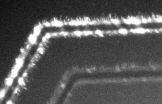(Press-News.org) Administering a new form of immunotherapy to children with neuroblastoma, a nervous system cancer, increased the percentage of those who were alive and free of disease progression after two years, according to researchers at the University of California, San Diego School of Medicine and fellow institutions. The percentage rose from 46 percent for children receiving a standard therapy to 66 percent for children receiving immunotherapy plus standard therapy, according to the study published in the Sept. 30, 2010 issue of the New England Journal of Medicine.
"This is the first clinical trial to document that a combination of anti-cancer monoclonal antibody (mAb) with cytokines is an effective anti-cancer therapy," said Alice L. Yu, MD, PhD, study chair and Professor of Pediatric Hematology Oncology at Moores UCSD Cancer Center. "This is also the first time a mAb targeting a glycolipid is shown to be effective for cancer immunotherapy since all therapeutic anti-cancer mAbs previously approved by FDA are directed against protein antigen. Overall, these findings present a clear paradigm shift and establish immunotherapy as a cornerstone to high-risk neuroblastoma treatment. This immunotherapy regimen will now be standard of care for children in first remission."
Neuroblastoma is a cancer of the peripheral nervous system (found outside of the brain and spinal cord), and is responsible for 12 percent of all deaths due to cancer in children under 15 years of age. It is the most common non-brain solid tumor in children. Nearly 50 percent of patients with neuroblastoma have a high-risk form of the disease and have poor long-term survival despite very intensive treatment.
The previously established standard treatment for neuroblastoma uses high doses of chemotherapy to destroy as many cancer cells as possible. But this form of chemotherapy (myleoablative therapy) also destroys some normal blood-forming cells, so it is followed by giving back previously collected blood-forming cells to restore immune system function and blood cell formation. Patients who respond to this therapy are then given a derivative of vitamin A to further treat any remaining cancer cells. More than half of the patients with high-risk neuroblastoma treated in this manner succumb to the disease.
A newer approach to cancer treatment is immunotherapy, which in this instance uses an antibody called ch14.18 to target a substance on the surface of tumor cells called GD2. The GD2 is expressed by cancers such as neuroblastoma but is also present on some normal nerve cells. Early-phase studies demonstrated the safety and activity of ch14.18 when it was given with other drugs that boost the immune system. Those drugs include a factor which stimulates white blood cell growth and a hormone that increases the number and activity of certain types of immune cells.
In this study, 226 children with high-risk neuroblastoma who had responded to myeloablative therapy were randomly assigned to receive standard therapy (isotretinoin), or isotretinoin, ch14.18, and the immune system boosting drugs. The median time these patients were followed in the study was approximately two years. Although the original plan had been to compare outcomes after three years, the study stopped early because of the strongly positive results, allowing those on standard therapy to switch to ch14.18 immunotherapy if they wished.
Toxicities, including pain, low blood pressure, capillary leak and hypersensitivity reactions, were encountered with the immunotherapy treatment at a significantly greater rate than compared to those who just received the standard therapy. However, side effects in the immunotherapy group were temporary and primarily resolved when treatment was stopped.
INFORMATION:
The randomized phase III clinical trial was coordinated by the Children's Oncology Group (COG), a national consortium of researchers supported by the National Cancer Institute (NCI), part of the NIH.
Because there was no pharmaceutical company to make ch14.18 when the phase III trial started, NCI manufactured the agent and provided it to COG for the clinical trial. NCI continues to manufacture ch14.18 and to make it available to children with high-risk neuroblastoma through ongoing Children's Oncology Group clinical trials. NCI has identified a pharmaceutical partner, United Therapeutics Corp., Silver Spring, Md., that will eventually take over responsibility for manufacturing ch14.18 and which will be responsible for obtaining U.S. Food and Drug Administration approval of ch14.18 for the treatment of high-risk neuroblastoma.
Fellow researchers included Andrew L. Gilman, M.D., M. Fevzi Ozkaynak, M.D., Wendy B. London, Ph.D., Susan G. Kreissman, M.D., Helen X. Chen, M.D., Malcolm Smith, M.D., Ph.D., Barry Anderson, M.D., Judith G. Villablanca, M.D., Katherine K. Matthay, M.D., Hiro Shimada, M.D., Stephan A. Grupp, M.D., Ph.D., Robert Seeger, M.D., C. Patrick Reynolds, M.D., Ph.D., Allen Buxton, M.S., Ralph A. Reisfeld, Ph.D., Steven D. Gillies, Ph.D., Susan L. Cohn, M.D., John M. Maris, M.D., and Paul M. Sondel, M.D., Ph.D., for the Children's Oncology Group.
Addition of immunotherapy boosts pediatric cancer survival in children with neuroblastoma
2010-09-30
ELSE PRESS RELEASES FROM THIS DATE:
Notre Dame and Wyoming scientists genetically engineer silkworms to produce artificial spider silk
2010-09-30
A research and development effort by the University of Notre Dame, the University of Wyoming, and Kraig Biocraft Laboratories, Inc. has succeeded in producing transgenic silkworms capable of spinning artificial spider silks.
"This research represents a significant breakthrough in the development of superior silk fibers for both medical and non-medical applications," said Malcolm J. Fraser Jr., a Notre Dame professor of biological sciences. "The generation of silk fibers having the properties of spider silks has been one of the important goals in materials science."
Natural ...
CEO's fate in hands of external constituents
2010-09-30
A CEO's fate might be in the hands of external constituents, according to a new study from Rice University's Jones Graduate School of Business. The study found that investment analysts and their negative stock ratings can sway a board to dismiss its CEO.
Conventional research has focused on internal factors that contribute to CEO dismissal -- poor firm performance and organization power and politics. But the new study, published by the Strategic Management Journal, turned its attention outward to discover the significant influence investment analysts have on a board ...
NRL's Wide-Field Imager selected for Solar Probe Plus mission
2010-09-30
NASA has chosen the Naval Research Laboratory's (NRL's) Wide-field Imager to be part of the Solar Probe Plus mission slated for launch no later than 2018. The Solar Probe Plus, a small car-sized spacecraft will plunge directly into the sun's atmosphere approximately four million miles from our star's surface. It will explore a region no other spacecraft ever has encountered in an effort to unlock the sun's biggest mysteries.
For decades, scientists have known that the corona, or the outer atmosphere, is several hundreds of times hotter than the visible solar surface ...
New NIST 'standard cigarette' available for fire-resistance testing
2010-09-30
Cigarettes are the most frequent cause of fatalities from residential fires in the United States. So, it might seem surprising to learn that a cigarette that burns stronger than others has been used for decades by manufacturers of home furnishings to test the fire resistance of their products. Making certain that they can continue this life- and property-saving effort is the job of a new standard reference material (SRM) from the National Institute of Standards and Technology (NIST).
NIST SRM 1196, "Standard Cigarette for Ignition Resistance Testing," consists of 10 packs ...
Studies show improved patient tolerance for unsedated colonoscopy using novel water method
2010-09-30
OAK BROOK, Ill. – September 29, 2010 – The October issue of GIE: Gastrointestinal Endoscopy, the monthly peer-reviewed scientific journal of the American Society for Gastrointestinal Endoscopy (ASGE), features the results of two randomized controlled trials of unsedated colonoscopy comparing water infusion versus air insufflation to distend the colon. Both studies showed that patient tolerance with the water method during unsedated colonoscopy was greater than with air insufflation and enhanced patient willingness to undergo a repeat unsedated exam; however, the cecal intubation ...
Growing nanowires horizontally yields new benefit: 'nano-LEDs'
2010-09-30
While refining their novel method for making nanoscale wires, chemists at the National Institute of Standards and Technology (NIST) discovered an unexpected bonus—a new way to create nanowires that produce light similar to that from light-emitting diodes (LEDs). These "nano-LEDs" may one day have their light-emission abilities put to work serving miniature devices such as nanogenerators or lab-on-a-chip systems.
Nanowires typically are "grown" by the controlled deposition of molecules—zinc oxide, for example—from a gas onto a base material, a process called chemical vapor ...
NIST 'Vision Science Facility' aims for lighting revolution
2010-09-30
Light-emitting diodes, or LEDs, have become popular with backpackers and cyclists who mount them on headbands for a reliable, hands-free source of illumination. Now, a new lab at the National Institute of Standards and Technology (NIST) is helping to bring these tiny but brilliant devices into your home, to help save both energy costs and the environment.
"LEDs can be very energy efficient, and they are a lot smaller and last a lot longer than light bulbs," says NIST vision scientist Wendy Davis. "They're what we'll likely use in the future to light our houses and public ...
Children's well-being and varying degrees of family instability
2010-09-30
Bowling Green, OH—September 29, 2010— A forthcoming issue of the Journal of Marriage and Family states that children today are less likely to be born into a "traditional" family structure, defined as two biological married parents. Growing numbers of children in the United States experience multiple family living arrangements during childhood. How these transitions affect the individual child's well-being needs to be fully addressed by researchers and policymakers alike. This article fully reviews the existing research from the past ten years on these topics in an effort ...
NIST residential fire study education kit now available
2010-09-30
Researchers from the National Institute of Standards and Technology (NIST) and the International Association of Fire Fighters have prepared an educational resource for fire chiefs, firefighters, and public officials to summarize and explain the key results of a landmark study on the effect of the size of firefighting crews on the ability of the fire service to protect lives and property in residential fires.
The study, Report on Residential Fireground Field Experiments, was published by NIST last April. The study is the first to quantify the effects of crew sizes and ...
MD Anderson study finds increases in 5-, 10-year survival at every stage of breast cancer
2010-09-30
VIDEO:
This study finds higher survival rate at every stage of breast cancer.
Click here for more information.
HOUSTON - Advances in screening for disease detection, better surgical techniques available to more women, and an increased number of therapies that reduce the risk of relapse in patients with both locally advanced and early stage disease, have collectively contributed to dramatic improvements in breast cancer's survival rates, according to a review of 60 years ...


